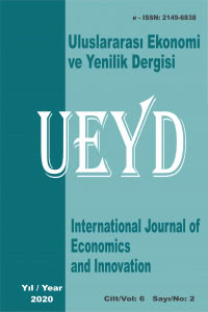Kadınların İstihdamı ve Boşanma İlişkisi: Türkiye Üzerine Ampirik Bir Analiz
The Relationship between Women’s Employment and Divorce: An Empirical Analysis on Turkey
___
- Bremmer, D. and Kesselring, R. (2014). Divorce and Female Labor Force Participation: Evidence from Times-Series Data and Cointegration. Atlantic Economical Journal, 32(3), 157-190.
- Bozkaya, G. (2013). Kadınların İşgücüne Katılımını Belirleyen Faktörler: Türkiye Üzerine Bir Analiz. Sosyal Bilimler Dergisi, 3(5), 69-89.
- Cafrı, R. and Çukadar, Ö. P. (2018). Boşanmanın Sosyo-Ekonomik Nedenleri Üzerine Mekânsal Ekonometrik Bir İnceleme. International Journal of Economic and Administrative Studies, Prof. Dr. Harun Terzi Özel Sayısı, 407- 424.
- Çatalbaş, K. G. (2015). Kadınların İşgücüne Katılımını Belirleyen Faktörlerin Belirlenmesi: Panel Veri Yaklaşımı. Kafkas Üniversitesi İktisadi ve İdari Bilimler Fakültesi Dergisi, 6(10), 249-280.
- D'amico, R. (1983). Status Maintenance or Status Competition? Wife's Relative Wages as a Determinant of Labor Supply and Martial Instability. Social Forces, 61(4), 1186-1205.
- Dickey, D. A. and Fuller, W. A. (1979). Distribution of the Estimators for Autoregressive Time-Series with a Unit Root. Journal of the American Statistical Association, 74(366), 427-431.
- Enders, W. (2010). Applied Econometrics Time Series, 3th. Ed., John Wiley & Sons, Inc.
- Greene, W. H. and Quester, A. Q. (1982). Divorce Risk and Wives' Labor Supply Behavior. Social Science Quarterly, 63(1), 16-27.
- Johansen, S. and Juselius, K. (1990). Maximum Likelihood Estimation and Inferences on Cointegration with Applications to the Demand for Money. Oxford Bulletin of Economics and Statistics, 52(2), 169-210.
- Johansen, S. (1991). Estimation and Hypothesis Testing of Cointegrated Vectors in Gaussian Vector Autoregressive Models. Econometrica, 59(6), 1551-1580.
- Johnson, W. and Skinner, J. (1986). Labor Supply and Marital Separation. The American Economic Review, 76(3), 455-469.
- Kılıç, D. and Öztürk, S. (2014). Türkiye’de Kadınların İşgücüne Katılımı Önündeki Engeller ve Çözüm Yolları: Bir Ampirik Uygulama. Amme İdaresi Dergisi, 47(1), 107-130.
- Kneip, T. and Bauer, G. (2007). Effects of Different Divorce Probabilities on Female Labor Force Participation and Fertility. http://www.mzes.unimannheim.de/publications/wp/wp-102.pdf?gathStatIcon=true (Erişim: 16.03.2018).
- Kutlar, A., Erdem, E. and Aydın, F. F. (2012). Kadınların İşgücüne Katılması İle Doğurganlık, Boşanma ve Ücret Haddi Arasındaki İlişki: Türkiye Üzerine Bir Araştırma. Bilgi Ekonomisi ve Yönetimi Dergisi, 7(1), 149-168.
- Lombardo, K. V. (1999). Women's Rising Market Opportunities and Increased Labor Force Participation. Economic Inquiry, 37(2), 195-212.
- Micheal, R. T. (1985). Consequences of the Rise in Female Labor Force Participation Rates: Questions and Probes. Journal of Labor Economics, 3(1), 117-146.
- Montalto, P. C. (1994). Married Women's Labor Force Participation as Divorce Insurance. Financial Counseling and Planning, 5, 191-206.
- Parkman, M. A. (1992). Unilateral Divorce and the Labor-Force Participation Rate of Married Women, Revisited. The American Economic Review, 82(3), 671-678.
- Peters, E. H. (1986). Marriage and Divorce: Informational Constraints and Private Contracting. The American Economic Review, 76(3), 437-454.
- Phillips, P. C. B. and Perron, P. (1988). Testing for a Unit Root in Time-Series Regression. Biometrika, 75(2), 334-346.
- Poortman, A. and Kalmijn, M. (2002). Women’s Labour Market Position and Divorce in the Netherlands: Evaluating Economic Interpretations of the Work Effect. European Journal of Population, 18, 175-202.
- Poortman, A. (2005). Women’s Work and Divorce: A Matter of Anticipation? A Research Note. European Sociological Review, 21(3), 301-309.
- Sander, W. (1985). Women, Work, and Divorce. The American Economic Review, 75(3), 519-523.
- Shapiro, D. and Shaw, L. (1985). Growth in Supply Force Attachment of Married Women: Accounting for Changes in the 1970s. Southern Economic Journal, 6(3), 307-29.
- South, J. S. (1985). Economic Conditions and the Divorce Rate: A Time-Series Analysis of the Postwar United States. Journal of Marriage and Family, 47(1), 31-41.
- Spitze, G. and South, S. (1985). Women's Employment, Time Expenditure, and Divorce. Journal of Family Issues, 6(3), 307-29.
- Stevenson, B. (2008). Divorce Law and Women’s Labor Supply. Journal of Empirical Legal Studies, 5(4), 853-873.
- Üçler, G. and Kızılkaya O. (2014). Kadın İstihdamının Boşanma ve Doğurganlık Üzerine Etkileri: Türkiye Üzerine Bölgesel Panel Veri Analizi. Akademik, Sosyal Araştırmalar Dergisi, 2(2), 28-43.
- Vignoli, D., Styrc, M., Matysiak, A. and Tocchioni, V. (2018). The positive impact of women’s employment on divorce: Context, selection, or anticipation?. Demographic Research, 38, 1057-1110.
- Yazıcı, M. A. (2018). Medeni Durumun ve Eğitimin Kadınların İşgücüne Katılımına Etkisi: TÜİK Verileri Üzerine Ampirik Bir Çalışma. İktisat Politikası Araştırmaları Dergisi, 5(2), 101-116.
- Zengi, C. A. (2018). Türkiye’de Medeni Durumun Kadın İstihdamına Etkisi. Social Sciences Studies Journal, 4(18), 1659-1670.
- ISSN: 2149-6838
- Yayın Aralığı: Yılda 2 Sayı
- Başlangıç: 2015
- Yayıncı: Seyfettin Artan
Türkiye’de Doğrudan Yabancı Yatırımlar, Karbon Emisyonu ve İktisadi Büyüme: Veriye Dayalı Bir Analiz
Göç, İşsizlik ve Gelir Arasındaki İlişkilerin Analizi: OECD Ülkeleri Örneği*
Financial Performance Evaluation of Food and Drink Index Using Fuzzy MCDM Approach
İnovasyon Etkenlerinin Araştırılması ve Optimal İnovasyon Portföy Yapılanması
Sürdürülebilir Gelişmede Yerel Halkın Rolü: Urla Örneği
Elif DİKMEN DİRİÖZ, Mükerrem ARSLAN
The Relationship between Women’s Employment and Divorce: An Empirical Analysis on Turkey
Kadınların İstihdamı ve Boşanma İlişkisi: Türkiye Üzerine Ampirik Bir Analiz
Göç, İşsizlik ve Gelir Arasındaki İlişkilerin Analizi: OECD Ülkeleri Örneği
Gıda ve İçecek İndeksinin Finansal Performans Değerlendirmesinde Bulanık ÇKKV Yaklaşımı
Financial Performance Evaluation of Food and Drink Index Using Fuzzy MCDM Approach*
